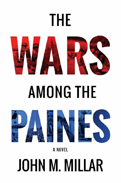
 |
In his first novel, septuagenarian John Millar uses an interesting mix of literary styles to educate his readers about the nature of war, its cost in blood, and its consequences in the lives, loves, and hopes of those who chose or were forced to wage it. The sweeping saga that unfolds places the action both in actual wartime battles on foreign soil and also back home. That's where other kinds of wars, ones that don't start with basic training—generational wars, race wars, family wars, societal wars—prove to have just as much drama and consequence as the bloodstained wars that use fatigues and weapons. The author served in Vietnam, received two Bronze Stars, an Air Medal, and a Commendation Medal from the U.S. Army, and then spent four decades stateside in business and industry.
That Millar has the experience, memory, and principles to attempt such a fictional epic is undeniable. He shares that the novel took him more than fifty years to write and grew into a larger volume than he anticipated. It is obvious that this is a highly motivated undertaking. At times, it almost resembles a literary classic about war and its aftermath. Because there are so many directions, methodologies, and styles present in the book, it can sometimes be difficult to keep up with the narrative flow. However, the individual pieces—journal entries, poems, song lyrics, song lists, history lessons, geography lessons, and more—are in themselves acceptable literary pursuits. The author is to be commended on his effort to do something new and different, as well as on his desire to share the truth of the terrible costs of war on humanity.